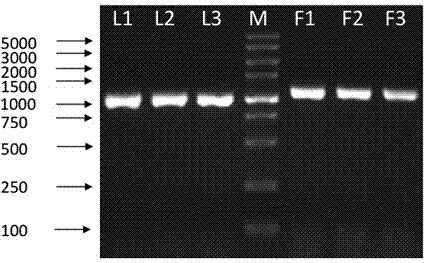Construction and expression of D-LDH-FDH fusion gene capable of improving D-phenyllactic acid yield
A technology of D-LDH-FDH and phenyl lactic acid, which is applied in genetic engineering, plant gene improvement, DNA preparation, etc., can solve the problems of increased reaction costs, etc., and achieve the effects of convenient function assistance, easy operation, and strong catalytic effect
- Summary
- Abstract
- Description
- Claims
- Application Information
AI Technical Summary
Problems solved by technology
Method used
Image
Examples
Embodiment 1
[0045] This example illustrates the construction of a dual-enzyme co-expression vector.
[0046] 1PCR primer design
[0047] On the basis of retaining the functional regions of D-LDH and FDH genes, design PCR primers, design an overlapping complementary fragment between the downstream primer of D-LDH and the upstream primer of FDH, and add a flexible connecting peptide sequence (linker).
[0048] 1.1D-LDH primer: the upstream primer (PL1) is as follows:
[0049] 5'-CGC GGA TCC G AA AAT TAT TGC ATA TGC-3' (the underlined part is the BamHI restriction site)
[0050] The downstream primer (PL2) is as follows:
[0051] 5’-GTC AAA CTT AAC TTG TGTG-3’
[0052] 1.2 FDH primer: a section (underlined part) of the FDH upstream primer overlaps and is complementary to the D-LDH downstream primer, and is used to connect the two genes when fusion PCR is performed. Wherein Gly4-Ser-Gly4-Ser-Gly4-Ser is a specially designed connecting peptide sequence. The FDH upstream primer (PF1) i...
Embodiment 2
[0073] This example illustrates the construction of recombinant bacteria and the induced expression of fusion proteins.
[0074] 1. Construction of recombinant bacteria
[0075] The above recombinant vector pET-Duet-D-LDH-Linker-FDH was transformed into Escherichia coli BL21(DE3), and positive clones were screened to obtain BL21(DE3) / pET-Duet-D-LDH-Linker-FDH recombinant bacteria.
[0076] 2. Induced expression of fusion protein by recombinant bacteria
[0077] Inoculate the transformed BL21(DE3) / pET-Duet-D-LDH-Linker-FDH single colony in LB liquid medium containing 50mg / L ampicillin, and culture overnight at 37°C and 200r / min (about 9h) Inoculate 1% in fresh LB medium containing the same concentration of ampicillin, culture at 37°C and 200r / min until the OD600 is about 0.6-0.8, add IPTG concentration to 0.6mmol / L, and lower the induction temperature to 25°C, After induction at 200r / min for 5h, the cells were collected by centrifugation, washed twice with PBS, resuspended in...
Embodiment 3
[0079] This example illustrates the transformation of whole cells of recombinant Escherichia coli to synthesize phenyllactic acid.
[0080] Pick a single colony of recombinant bacteria and inoculate it in LB liquid medium containing 50mg / L ampicillin, culture overnight at 37°C and 200r / min (about 9h), and inoculate it at 1% in fresh LB medium containing the same concentration of ampicillin At 37°C and 200r / min, when the OD600 was about 0.6-0.8, IPTG concentration was added to 0.6mmol / L, and the induction temperature was lowered to 25°C. After induction at 200r / min for 5h, the bacteria were collected by centrifugation and washed with PBS for two times. Second, the prepared sludge was used for whole cell transformation. Resuspend the collected bacteria in transformation medium containing 20g / L glucose and 9g / L sodium phenylpyruvate at pH 7.0, make the dry weight of recombinant Escherichia coli 20g / L, transform at 37°C and 200r / min constant temperature shaking Cultivate and samp...
PUM
 Login to View More
Login to View More Abstract
Description
Claims
Application Information
 Login to View More
Login to View More - R&D
- Intellectual Property
- Life Sciences
- Materials
- Tech Scout
- Unparalleled Data Quality
- Higher Quality Content
- 60% Fewer Hallucinations
Browse by: Latest US Patents, China's latest patents, Technical Efficacy Thesaurus, Application Domain, Technology Topic, Popular Technical Reports.
© 2025 PatSnap. All rights reserved.Legal|Privacy policy|Modern Slavery Act Transparency Statement|Sitemap|About US| Contact US: help@patsnap.com



